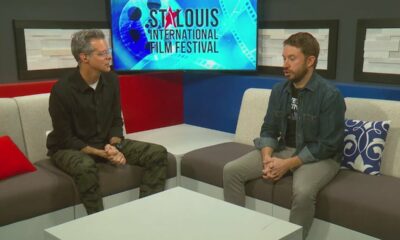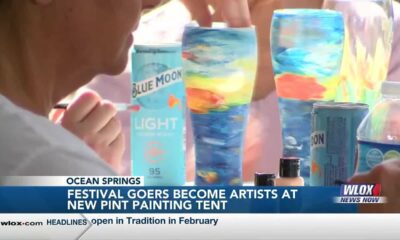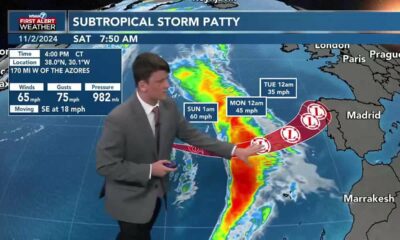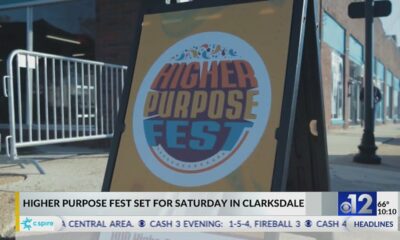Mississippi News
Matt de la Peña: Author Q&A
Beginning to question first impressions: Q&A with author Matt de la Peña

Gazing across a subway car full of enticing, strange faces, young Milo thrusts his imagination into action.
The wondrous train ride is the setting of “Milo Imagines the World,” a children’s picture book written by Matt de la Peña and illustrated by Christian Robinson.
The story follows Milo, who wields his sketchpad to explore the mysterious lives of his fellow passengers. But while diving deep into his make-believe backstories, the boy pauses to reflect, and begins to see the boundaries of first impressions.
“Milo Imagines the World,” published last summer, is the duo’s second picture book exploring the world of public transportation through the lens of working class communities. The two also partnered on the New York Times bestseller “Last Stop on Market Street,” which won the 2016 Newbery Medal.
De la Peña, set to appear at the Mississippi Book Festival in Jackson on Aug. 20, spoke with Mississippi Today about his latest work.
Editor’s note: This interview has been edited for clarity and length.
Mississippi Today: You mentioned having a focus on writing for working class folks and exploring public transportation, with this book and your last one, “Last Stop on Market Street.” Can you talk a little bit about that intersection in your work?

Matt de la Peña: I’m always drawn to working class communities, just because I grew up in one. I grew up near the border of San Diego and Mexico, and I have grandparents from Mexico, and my dad was first gen. So that’s something I always want to feature in anything I write, people who are working hard and trying to make a life in America.
The way I describe it is, my goal is to be as honest as possible, but in the back of my head I want to show moments of grace and dignity in these communities.
It’s funny because when I first started out writing, my stories would always be pushed toward kids who were living in those communities or who were diverse racially. That was annoying to me because these stories are for everyone. I think we’re seeing a push now, where a story that focuses on a kid like Milo, now will be celebrated in a private school with predominantly white kids, well-to-do kids. That’s a nice thing to see.
Early in my career, I remember a teacher at a conference finding me and saying, ‘Hey Matt, I really like your books. But I’ll be honest, we don’t really have those kids at our schools, so we don’t have that many copies.’
I remember saying to her, ‘How many wizards do you have at your school?’ Because of this idea of, we can read books about wizards but not kids from different backgrounds.
What’s interesting is public transportation, it really depends on where you are, who’s on it. So in “Last Stop on Market Street” and where I grew up in San Diego, if you’re on the bus, you are there – pretty much 99% chance – because you don’t have a car, you can’t afford a car. It’s usually all working class people on the bus. If you go to New York City, you could be on the subway next to a CEO, and on the other side of you is someone who cleans that building. So I find those stories change dramatically if you’re going to explore public transportation depending on what city it is.
That also factors into Milo’s journey. He’s looking around at these people and sees the kid with the perfect part (in his hair) and thinks, ‘This kid’s rich.’ He sees the guy with the scruffy face and thinks, ‘This guy’s poor and lonely.’ So part of his journey is to kind of challenge that idea.
MT: On the subway, you’re exposed to so much from so many different people at once. How do you capture that from a young child’s perspective?
MD: You know what’s amazing about public transportation is, you learn the truth, which I think kids growing up in car culture don’t quite grasp. The truth is, we kind of think our story is the most important. And if you’re in a car, you think that even more. It’s almost like everyone’s in the movie starring you.
But if you grow up taking public transportation and you just look around and watch people and listen to conversations, it’s so much easier to grasp that you are just one of millions of stories.
So I actually think that’s one of the healthiest parts about growing up taking public transportation, is you sort of position your story alongside other stories. And when you’re in a car culture, you don’t have as many opportunities to see that.
MT: I wanted to ask you about, you kind of summarized it nicely in the dedication page – the message: “For those who dare to imagine beyond the first impression.” It got me thinking about the fact you’re writing through a child’s perspective, and how we typically think of kids being more imaginative. I was wondering if you thought writing from Milo’s perspective made it easier to give him a broader imagination of what people might be like because he’s a kid and he’s got this creative mind. Is that fair to say?
MD: I actually think I would approach it almost the same way from an adult’s perspective. I just think the big difference would be the arc of an adult’s story. If it was the same storyline, I would approach the arc of it, the movement at the end where Milo’s re-thinking the pictures, I think with an adult it would be louder, and it would be more direct.
One of my favorite things about writing a picture book and thinking about the character’s arc is that, really, I don’t think it’s truthful if you get to the end of a picture book and the character has arced dramatically. I think it’s much more honest to show a character who is just beginning that arc. Things like Milo’s experience, it has to happen dozens of times for it to sink in and for you to move as a person.
As an adult, I think a lot of people are just as imaginative, maybe not quite as imaginative as a kid, but you still tell yourself the story of the people around you. But I think the ending of a picture book shouldn’t be as dramatic.
MT: (Spoiler alert) The end of the book (where the reader learns Milo is going to visit his mother in prison) caught me off guard. Was it important for you to make that a surprise, and if so what do you think was the effect of that?
MD: It is kind of a surprise, but my hope is that if you read it again, everything is leading that direction. He’s a shook-up soda, because he’s excited to see his mom but he’s also anxious. He doesn’t know how to feel about it. The whole story is about where he’s going, but it’s quiet. And then at the end it’s a revelation about where he’s going, but it’s not that I wanted it to be a big surprise.
It fits with the story, if that makes sense. He’s looking out so that he doesn’t have to directly look in, although like we talked about that’s what he’s kind of processing.
And at the very end he’s showing his mom this picture he worked very hard on the night before. He of course shows her a picture of them, sitting on the stoop, and she’s not in prison.
So he’s doing something that I have taped on my wall, above my computer, as a writer, I live by this motto: do not write what you see, write what will be seen. Because one of the things you can do writing a kid’s book is help sort of reveal the world of tomorrow. And I think what he’s doing when he’s showing them the picture is he’s also drawing not what he sees today but he hopes will be seen tomorrow.
Really, the surprise ending for me as the writer is not that his mom is in prison, but it’s the piece of art that he shows his mom.
MT: There was a part in the book, it might feel like a small detail, but it told me, okay, you’ve clearly spent some time thinking through the mind of a kid: Milo is looking at his reflection and thinking about his own life and his aunt’s apartment, and the fact he calls it his “aunt’s apartment near the cemetery” really stood out to me because that’s something I remember doing as a kid, associating these two things that aren’t related but are just next to each other.
How do you generally get in the process of getting into a kid’s mind and transport yourself there?
MD: Forgive me if I’m going a little too deep on this, but you identified what this book is really about. There is so much going on in Milo’s unconscious through the book. Because if you look at each vignette he comes up with for the people he’s looking at, he’s sketching out who he thinks they are, where they’re going, but he’s also sort of exorcising his own situation, because every vignette has some form of, either emancipation or building up a wall. He’s really thinking about his mother being in a place where he can’t access her all the time.
If you look at the first vignette, he’s looking at a bird in a cage, but in his vignette the birds get to go free. And the married couple, they rise above the walls of the city and they’re free. And then the boy who’s wealthy, he’s got this castle, and after he goes through, the drawbridge is going to close again so he can protect all his stuff. Every vignette is about other people, but he’s using it as a way to explore his current situation.
Now, does any kid get that? Probably not. But I have this theory, especially for writing about young people: we often say it’s more valid to get something consciously than it is to get it viscerally.
And what I love about kids books is, kids are mostly operating on that visceral feeling. Even if a kid can’t say, ‘Oh I see there’s a form of emancipation in each vignette,’ a kid might feel it. And that to me is just as valid as, you’re in a college course and pulling out every symbol and every detail.
MT: What do you think Milo learns on this journey? Like you said, it takes a while and it’s not a complete learning experience by the end, but how do you think this learning experience is helping Milo grow?
MD: I think what Milo is doing at the end of the book is he’s starting to question the way he sees other people, and whether or not his first impression is the right impression. And he’s starting to think that way because he’s also along the way starting to understand how others might see him.
So when he looks at his reflection, he’s starting to think, what do people think of my face? And then he lists a few things that are real, this is who he is to himself, but maybe others can’t access that. Through that, and misjudging this boy with the part, I think he’s beginning to question this idea of first impressions.
As kids, we learn how to access those stereotypes, but to be an intelligent person, you have to then almost dismantle those stereotypes. So he’s learning through early life how to acquire those stereotypes. Maybe he’s just beginning to question them, which may ultimately lead to him dismantling them.
This article first appeared on Mississippi Today and is republished here under a Creative Commons license.
Mississippi News
Events happening this weekend in Mississippi: April 25-27
SUMMARY: This weekend in Mississippi (April 25-27) features a variety of events across Central and Pine Belt regions. Highlights include MiraGotSoul at Vibe Studio in Jackson, a community Dinner and Movie in Clinton, and the Natchez Kite Festival. Enjoy live performances with Sweet Lizzy Project in Natchez and the New Bourbon Street Jazz Band in Clinton. Family-friendly activities include the Native Plant Fest and Community Farmers Market in Jackson. In Hattiesburg, catch the Henry Cho tour and the Downtown Crawfish Jam Music Festival. Overall, it’s a weekend full of entertainment, culture, and fun activities for all ages.
The post Events happening this weekend in Mississippi: April 25-27 appeared first on www.wjtv.com
Mississippi News
Events happening this weekend in Mississippi: April 18-20
SUMMARY: This weekend (April 18-20), Mississippi offers a variety of events for all ages. In Jackson, enjoy Food Truck Friday, a jazz concert, free outdoor movie screenings, and multiple exhibitions including “Of Salt and Spirit” and “Hurricane Katrina: Mississippi Remembers.” For family fun, there’s an Easter Egg Hunt at the Ag Museum and “Bunnies & Butterflies” at MCM. Natchez features the Spring Pilgrimage, Lafayette’s 200th anniversary celebration, and a farmers market. In the Pine Belt, highlights include Live at Five, a Spring Candle-Making Workshop, and Easter events at the Hattiesburg Zoo. Don’t miss the Bluff City Block Party and more!
The post Events happening this weekend in Mississippi: April 18-20 appeared first on www.wjtv.com
Mississippi News
Events happening this weekend in Mississippi: April 11-13
SUMMARY: This weekend in Mississippi (April 11-13), enjoy a variety of events across the state. Highlights include the Eudora Welty Birthday Bash in Jackson, Trivia Night at the Mississippi Museum of Natural Science, and Boots & Bling Fundraiser in Natchez. For family fun, check out the Bunny Bonanza in Jackson or the Easter Egg Hunt in Clinton. The Natchez Concours d’Elegance Car Show and Stranger Than Fiction Film Festival offer cultural experiences, while the 12th Annual Dragon Boat Regatta in Ridgeland and the Hub City Classic Car Show in Hattiesburg provide exciting activities for all ages.
The post Events happening this weekend in Mississippi: April 11-13 appeared first on www.wjtv.com
-

 SuperTalk FM6 days ago
SuperTalk FM6 days agoNew Amazon dock operations facility to bring 1,000 jobs to Marshall County
-

 News from the South - Missouri News Feed2 days ago
News from the South - Missouri News Feed2 days agoMissouri lawmakers on the cusp of legalizing housing discrimination
-

 News from the South - Alabama News Feed6 days ago
News from the South - Alabama News Feed6 days agoPrayer Vigil Held for Ronald Dumas Jr., Family Continues to Pray for His Return | April 21, 2025 | N
-

 News from the South - Florida News Feed6 days ago
News from the South - Florida News Feed6 days agoTrump touts manufacturing while undercutting state efforts to help factories
-

 News from the South - Florida News Feed6 days ago
News from the South - Florida News Feed6 days agoFederal report due on Lumbee Tribe of North Carolina’s path to recognition as a tribal nation
-

 News from the South - Virginia News Feed7 days ago
News from the South - Virginia News Feed7 days agoTaking video of military bases using drones could be outlawed | Virginia
-

 Mississippi Today4 days ago
Mississippi Today4 days agoStruggling water, sewer systems impose ‘astronomic’ rate hikes
-

 News from the South - Oklahoma News Feed6 days ago
News from the South - Oklahoma News Feed6 days agoOklahoma Treasurer’s Office Faces Scrutiny Over Use of Signal in Anti-ESG Coordination















































